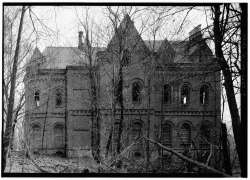Wyndcliffe
Wyndcliffe is the ruin of a historic mansion near Rhinebeck in Dutchess County, New York. The records at the Library of Congress state that the brick mansion was originally named Rhinecliff and constructed in 1853 in the Norman style. The mansion was built for New York City socialite Elizabeth Schermerhorn Jones (1810-1876) as a weekend and summer residence. The design is attributed to local architect George Veitch. A master mason, John Byrd, executed the highly varied ornamental brickwork using only rectangular and few molded bricks.
Wyndcliffe | |
U.S. National Historic Landmark District Contributing Property | |
 HABS north view of Wyndcliffe from an unknown date. | |
| Location | Rhinecliff |
|---|---|
| Architect | George Veitch |
| Architectural style | Norman |
| Part of | Hudson River Historic District (ID90002219) |
| Significant dates | |
| Added to NRHP | December 14, 1990[1] |
| Designated NHLDCP | December 14, 1990[2] |
The adjacent hamlet to the north of Wyndcliffe was originally platted as "Kipsbergen" (1686); the hamlet was later renamed as "Rhinecliff" after the Jones-Schemerhorn estate of the same name. Writer Edith Wharton was a frequent childhood visitor.[3] The phrase "keeping up with the Joneses" is thought to originate from the Wyndcliffe estate.[4]
In 1886, the mansion and land was sold by the executors of the will of Elizabeth S. Jones to Andrew Finck (1829-1890) for $25,000.[5] Wyndcliffe was later known as Linden Hall or Finck Castle, for those subsequent owners. Andrew Finck was a New York City brewer whose son August Finck (1854-1905) and grandson August Finck Jr. (1879-1915) operated one of the larger breweries in New York City. The mansion passed from Andrew to his grandson August in 1901 and then to another of Andrew's grandsons, Theodore Finck (1883-1923) in 1919. Theodore died in the mansion in 1923, identifying his daughter Anna Wolf Finck Rice (1879-1963) in his Last Will as his sole devisee. The mansion and 31.8 acres passed to Nissan S. Hanoka, Rebecca hanoka and Mrs. Victori Hazen in 1927 for $100 plus a $5,000 mortgage. In 1934, the property was awarded back to Anna Wolf Rice for $1,117.94 at foreclosure auction, and then passed through several subsequent owners from 1936 onward.
The mansion was abandoned sometime around 1950. Originally situated on 80 acres including waterfront access to the Hudson River, the property was eventually reduced to 2.5 acres.[6] Portions of the mansion have collapsed after nearly 70 years of abandonment. In 2003 the mansion was sold and the new owner erected a security fence around the property. However the announced plans to restore the house never came to fruition. In September 2016 the house was sold for $120,000 at auction.[7] The new buyer filed an application to demolish the remaining structure. Images taken in early 2017 showed that major sections of the second story had collapsed.[8]
References
- "National Register Information System". National Register of Historic Places. National Park Service. January 23, 2007.
- "Hudson River Historic District". National Historic Landmark summary listing. National Park Service. 2007-09-14.
- "Wyndclyffe, Mill Road, Rhinebeck, Dutchess County, NY". Historic American Buildings Survey. Library of Congress. Retrieved 20 October 2012.
- Smith, Alexandra. "Wyndcliffe: the Abandoned Mansion that allegedly inspired the idiom: 'Keeping up with the Joneses'". Urban Ghosts Media. Retrieved 8 March 2013.
- "Wyndcliffe (Linden Grove) Mill Road Rhinebeck Vicinity Dutchess County New York Historic American Buildings Survey National Park Service Department of the Interior Washington D.C. 20240 data gathered 1973-74 edited by HABS in 1981 as HABS No. NY-5627 HABS.NY.14-RHINB.V.2-". Pictorial. Retrieved 9 January 2019.
- "Surreal in New Jersey - Wyndcliffe". Retrieved 20 October 2012.
- Faircloth, Kelly (September 26, 2016). "Crumbling 'Keeping Up With the Joneses' Mansion Sells for a Paltry $120,000". Pictorial. Retrieved 28 July 2017.
- "Wyndclyffe Update – April 2017". Robert J. Yasinsac. Retrieved 26 June 2017.
External links
Historic information about the site is available at Historic American Buildings Survey: